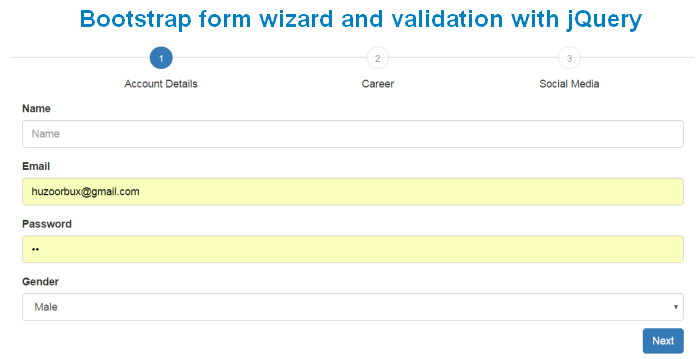Jquery Form Validation Tutorial Bootstrap
Think SECURITY when processing PHP forms! These pages will show how to process PHP forms with security in mind. Proper validation of form data is important to protect your form from hackers and spammers! The HTML form we will be working at in these chapters, contains various input fields: required and optional text fields, radio buttons, and a submit button: The validation rules for the form above are as follows: Field Validation Rules Name Required. + Must only contain letters and whitespace E-mail Required.
+ Must contain a valid email address (with @ and.) Website Optional. If present, it must contain a valid URL Comment Optional. Multi-line input field (textarea) Gender Required.
Jul 17, 2017 - What we have for you today is a selection of form validation jQuery plugins and libraries that will make your life a heck of a lot easier. (3.4KB minified) plugin that comes packaged with 18 basic validations, but does allow you to easily write your own validations and overwrite any default behaviours.

Must select one First we will look at the plain HTML code for the form. What is the htmlspecialchars function? The htmlspecialchars function converts special characters to HTML entities. This means that it will replace HTML characters like with. This prevents attackers from exploiting the code by injecting HTML or Javascript code (Cross-site Scripting attacks) in forms.
Big Note on PHP Form Security The $SERVER'PHPSELF' variable can be used by hackers! If PHPSELF is used in your page then a user can enter a slash (/) and then some Cross Site Scripting (XSS) commands to execute. Alert('hacked') This code adds a script tag and an alert command. And when the page loads, the JavaScript code will be executed (the user will see an alert box). This is just a simple and harmless example how the PHPSELF variable can be exploited. Be aware of that any JavaScript code can be added inside the.
' The exploit attempt fails, and no harm is done! Validate Form Data With PHP The first thing we will do is to pass all variables through PHP's htmlspecialchars function. When we use the htmlspecialchars function; then if a user tries to submit the following in a text field: location.href('- this would not be executed, because it would be saved as HTML escaped code, like this: location.href('The code is now safe to be displayed on a page or inside an e-mail.
We will also do two more things when the user submits the form:. Strip unnecessary characters (extra space, tab, newline) from the user input data (with the PHP trim function). Remove backslashes ( ) from the user input data (with the PHP stripslashes function) The next step is to create a function that will do all the checking for us (which is much more convenient than writing the same code over and over again). We will name the function testinput.
Now, we can check each $POST variable with the testinput function, and the script looks like this.
One of the typical tasks when developing a web site is building a form to accept information, feedback or comments from visitors. But before submitting the form, it becomes necessary for us to validate user input before submitting the data to the server. You can validate phone numbers, emails, addresses, dates, credit cards etc.
Depending on your requirements. In this article, I will show you a simple way to validate a form. For this purpose, we will use a plugin called Bootstrap Validator (project on ). This plugin is based on Twitter Bootstrap.js and offers some great and expanding list of features. Some of them are:. Bootstrap UI and web-fonts integration. Validator initialization based on plugin options or HTML data-attribute.
Some built-in fields validators like: length of the content, date, credit card, IBAN, IMEI, phone, and some others. Custom fields validators. Possibility to add multiple validators to each field. Possibility to show a feedback icon on the field after its validation. Possibility to show the validation messages in a specific HTML element.
Rich API’s to manipulate the plugin instance and behaviors. Some supported languages for localization. Bootstrap Validator ImplementationTo use Bootstrap Validator, we first need to add the following dependencies in our project:. jQuery. Bootstrap (js and css) To see it in action, we can build a form validation by checking that a typical contact form has a name, a valid e-mail address and a body text set.

Here are the dependencies included (from CDN): Boostrap Validator. Here is some simple HTML code representing the contact form: Full name Email Title Content
Jquery Form Validation Tutorial Bootstrap Template
Also remember to perform server-side validation in addition to client side validation as JavaScript can be turned off by the user, there by bypassing the validation on client-side! Smoke or fire the speakeasy rar. Will you give this article a +1? Thanks in advance.